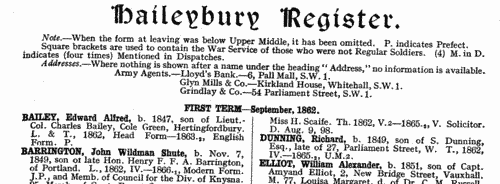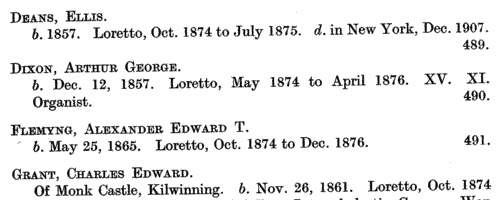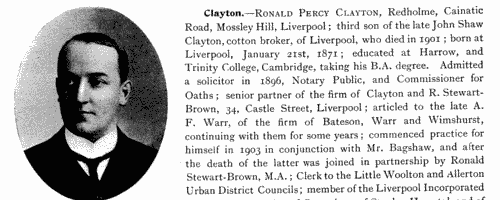Add this eBook to your basket to receive access to all 310 records. Our indexes include entries for the spelling banner. In the period you have requested, we have the following 310 records (displaying 261 to 270): These sample scans are from the original record. You will get scans of the full pages or articles where the surname you searched for has been found. Your web browser may prevent the sample windows from opening; in this case please change your browser settings to allow pop-up windows from this site.  British artillerymen fighting in South Africa
(1899-1902) British artillerymen fighting in South Africa
(1899-1902)
The Queen Victoria's South Africa Medal was awarded (after her death, in the event) to all who had served honourably in the various campaigns in the Boer War. Returns were made from each unit, and consolidated into nominal roll, of which this is the one for the Royal Artillery. Confusingly, the ledgers used had originally been printed for a register of men transferred (or re-transferred after mobilization) to 1st Class Army Reserve. All the original column headings were therefore struck through, and the roll was prepared with this information: Date of Issue; Regimental Number; Rank; Name; Unit; Medal (a 1 indicating that a medal was awarded); [number of] Clasps; the reference to the source in the original returns, usually starting with AG for papers in the hands of the Adjutant-General, and 68/Art/ for the Royal Artillery records. The final column, normally left blank, was occasionally used for explanatory remarks. | Sample scan, click to enlarge

| Boys entering Haileybury College, Hertfordshire
(1904)
Haileybury College, near Hertford, was founded by the East India Company in 1806, and incorporated by Royal Charter in 1864. This register of pupils entering the school from 1862 to 1931 was edited by a master there, Laurence Arthur Speakman. The boys are listed by term of joining the school, and then alphabetically by name (in bold), surname first (in capitals). There is then usually a precise birthdate, and the name and address of his father; his period at the school, starting with abbreviations to indicate the house to which he belonged (B., Batten; B. F., Bartle Frere; C., Colvin; E., Edmonstone; Ha., Hailey; Hi., Highfield; L., Lawrence; Le B., Le Bas; M., Melvill; Th., Thomason; T., Trevelyan), and the first and last forms attended (e. g., IV., fourth form). Where a member of a school team there is then an indication (e. g., XI., cricket). For some pupils, with whom the school had lost touch, Speakman was only able to record the details of their time at Haileybury; but for most a brief career synopsis is then given, and current address (as in 1931) or date of death.
| Sample scan, click to enlarge

| Ordinary Members of the Institute of Bankers
(1904)
The Journal of the Institute of Bankers for 1904 includes a list of Fellows (from which this scan is taken: an asterisk indicates a Life Fellow), of Associates (an asterisk indicates a Life Associate, and a dagger a holder of the certificate of the institute), and of Ordinary Members; there are also results of the institute's final examinations held from 11 to 13 April, in which the successful candidates are listed alphabetically by surname and full christian name(s), with the name and address of their bank (not their personal addresses). These final examinations entitled the successful candidates to the Certificate of the Institute of Bankers; those who obtained distinctions are so indicated in the lists (an asterisk for Commercial Law, dagger for Arithmetic and Algebra, double dagger for Practical Banking, double s for Commercial Geography and History, and double vertical line for Political Economy). There was also an examination taken after the Gilbart Lectures, with successful candidates being awarded money prizes, or certificates of distinction, or honour, or merit, and similar lists of these awards were also printed in the journal. | Sample scan, click to enlarge

| Carpenters Excluded from their Union: Birmingham (1907)
The 48th annual report of the Amalgamated Society of Carpenters and Joiners, from December 1906 to December 1907, gives lists of members excluded from the union: the great majority for arrears of membership fees, but some for 'non-payment of entrance money'; 'for working contrary to the society's interest'; 'false declaration of entry'; 'imposing on the society's funds'; 'withholding the funds of the society'; 'violating rule while on sick benefit'; 'bringing the society into discredit'; and 'members who have paid up and resigned'.
| Sample scan, click to enlarge

| Carpenters Excluded from their Union: Bromsgrove (1907)
The 48th annual report of the Amalgamated Society of Carpenters and Joiners, from December 1906 to December 1907, gives lists of members excluded from the union: the great majority for arrears of membership fees, but some for 'non-payment of entrance money'; 'for working contrary to the society's interest'; 'false declaration of entry'; 'imposing on the society's funds'; 'withholding the funds of the society'; 'violating rule while on sick benefit'; 'bringing the society into discredit'; and 'members who have paid up and resigned'.
| Sample scan, click to enlarge

| Boys entering Loretto School
(1908)
The Reverend Dr Thomas Langhorne, who came to Musselburgh in Midlothian as an Episcopalian Church clergyman, established a small school for boarders and day scholars at Loretto House, so called because the grounds contained the ruins of the mediaeval chapel of St Mary of Loretto. To celebrate the centenary of the school in 1925, a second edition of the school register was published, edited by A. H. Buchanan-Dunlop. Relatively little was known of many of the earliest scholars, but from 1835 onwards the register generally gives full name, in capitals, surname first; date of birth; period of time at Loretto; a brief biography; date of death; whether brother of any other boy in the register; and a sequential number. | Sample scan, click to enlarge

| Members of Durham University
(1910)
The alphabetical list of all living members of Durham University, issued in 1910, was compiled from the Admission Book and University Register. It gives surname, initials, degree, college, and date. Those marked with an asterisk were Members of Convocation. In the case of graduates in Arts, Theology (except in the case of Bachelors of Divinity) and Civil Law, the dates refer to the year in which the examination for the degree of B.A. was passed; in the case of Bachelors of Divinity who were not Graduates in Arts, of Licentiates in Theology, of Civil Engineers, and of Licentiates in Medicine, to the year in which each passed the Final Examination. In the case of Hygiene, Science, and Music, to the year in which the Examination for B.Hy., B.Sc., or B.Mus. was passed; and in the case of Graduates in Medicine to the year in which the Examination for the degree of M.B. was passed, except in the case of practitioners, when the date refers to the year in which the examination for the degree specified was passed. In cases where no date is given the degree is Ad Eundem, unless it is marked honorary. The abbreviations are: Arms., Armstrong College, Newcastle-upon-Tyne; Codr., Codrington College, Barbados; Cos., Bishop Cosin's Hall; F. Bay, Fourah Bay, Sierra Leone; Hatf., Bishop Hatfield's Hall; Med., College of Medicine, Newcastle-upon-Tyne; St. Chad's, St Chad's Hall; St. John's, St John's Hall; Univ., University College. | Sample scan, click to enlarge

| Steam Engine Makers in Cardiff
(1910)
The Steam Engine Makers' Society, a trades union, ended 1910 with 13,401 members in 144 branches. The 86th Annual Report gives a full list of members for each branch, followed by Travelling Expenses subsidised by the branch (with names and dates); Unemployed Expenses (with names and dates); Superannuation, Sick and Funeral Expenses (all with names and dates). | Sample scan, click to enlarge

|  London Metropolitan Police
(1902-1911) London Metropolitan Police
(1902-1911)
The London Metropolitan Police Register of Joiners (MEPO 4/337) lists policemen joining the force 14 July 1902 to 10 April 1911 (warrant numbers 88812 to 100006). The register is alphabetical, in so far as the recruits are listed chronologically grouped under first letters of surname. It gives Date of Appointment, Name, Number of Warrant, Cause of Removal from Force (resigned, dismissed, promoted or died), and Date of Removal. The information about removal is sometimes wanting. A final column of 'Remarks' is largely blank, but occasionally gives an alias or a cross-reference to another warrant number. The register is discoloured and damaged in places, and one or two pages are missing. | Sample scan, click to enlarge

| Obituary of the Eminent in Liverpool and Birkenhead
(1911)
The biographical part of 'Liverpool and Birkenhead in the Twentieth Century' was edited by William Thomas Pike. After opening with the Lord Bishop of Liverpool and the Lord Mayor of Liverpool, there are three main sections, dealing with Nobility, Gentry and Commerce; the Learned Professions; Accountants, Architects, Engineers &c.; and an Obituary. Each biography usually (but not invariably) has a photograph; full name (surname first, in bold; christian name(s) in capitals) and address; birth place and date; father's name (and sometimes details); a short biography; whether married, with wife's name and her father's name and address. | Sample scan, click to enlarge

|
Research your ancestry, family history, genealogy and one-name study by direct access to original records and archives indexed by surname.
|












